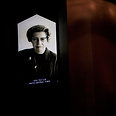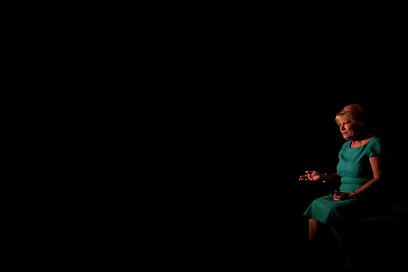
Taking on considerable peril, Jozef and Natalia Roztropowicz took in the child, baptized her as Irena and raised her as their own. Five years later, they made another gut-wrenching choice: Returning their beloved daughter to an adoptive Jewish family who moved with her to Israel two years later.
The child, now a 71-year-old woman named Sabina Heller, says they are the reason she is alive.
"I would have been dead if they hadn't taken me in ... (they gave me) not only life, but love," said Heller, a teacher and writer who now lives in Los Angeles. "The Roztropowicz family did two courageous things. First they took me in and the second time they let me go."
Heller only discovered the full details in 1999. The following year, Israel's Yad Vashem Holocaust museum and memorial recognized the Roztropowicz family as "Righteous Among the Nations," the highest honor given to non-Jews who risked their lives to save Jews during World War II.

Sabina Heller. 'They gave me not only life, but love' (Photo: AP)
Yad Vashem recently unveiled a new exhibition marking 50 years of recognizing these saviors and dedicated it to the 24,811 people from 47 countries who have been honored as "Righteous Among the Nations."
A special committee, chaired by a retired Supreme Court Justice, is responsible for vetting every case before awarding the title. Following a lengthy process, between 400 and 500 are typically recognized a year.
"The next generations need to know about these rare stars amid the darkness," said Rabbi Israel Meir Lau, who heads Yad Vashem's advisory council, and who himself credits one of those honored, a non-Jewish Russian named Feodor Mikhailichenko, with saving him as a child in the Buchenwald concentration camp.
Lau, a former chief rabbi of Israel, said that those who experienced the worst evil of man also know they could not have survived without the goodness of man, either.
"These people risked themselves, risked their families to protect us," he said at the opening ceremony. "There were lots of righteous, but not enough."
'Decision that no parents should have to make'
About six million European Jews were killed by German Nazis and their collaborators during World War II. The names of those honored for refusing to be indifferent to the genocide are engraved along an avenue of trees at the Jerusalem memorial.
The most famous cases are Oskar Schindler, whose efforts to save more than 1,000 Jews were documented in Steven Spielberg's 1993 film "Schindler's List," and Raoul Wallenberg, a Swedish diplomat who is credited for having saved at least 20,000 Jews before mysteriously disappearing. But the new exhibit aims to tell the stories of the lesser known cases, such as the Roztropowiczes.
The exhibition, "I Am My Brother's Keeper," features five eight-minute-long, animated video presentations of rescue stories projected in a dark, cavernous hall.
Yad Vashem broke down the rescuers into five different categories: "In the cellars, pits and attics" describes those who offered shelter and cared for those they hid. "Under the benefaction of the cross" pays tribute to rescuers who were members of the Christian clergy. "Paying the ultimate price" is dedicated to those who were killed as a result of their actions. "The courage to defy" honors those who refused their bureaucratic orders to help Jews. And finally, "Parting once again" tells the stories of those hidden children, like Heller, who lost their identities.
Heller is now widowed and has two grown sons.
She was born to the Kagan family in the city of Radyvyliv, today in Ukraine. Though she doesn't even know the names of her biological parents, who were burned to death inside a barn shortly after giving her up, and has no memory of them, she considers them heroes just like her Christian adoptive parents.
"Imagine the kind of decision they had to make, a decision that no parents should have to make – to separate themselves from their baby," she said. "They gave me life by doing that. There were a lot of Jewish parents at that time who couldn't bring themselves to do that and as a result they are all dead."
With the Roztropowicz family she went by the name Inka, before taking on a new name with the Jewish family that moved her to Israel. Her Jewish adopted mother kept her past a secret from her, hoping to give her a new beginning.
In was only in 1999, when she was 58 and after her mother had passed away, that her mother's cousin Rachel Rabin, incidentally, the lone sister of assassinated Israeli Prime Minister Yitzhak Rabin, came upon new information gleaned from an Israeli doctorate student's research on hidden children during the Holocaust that brought her background to light. She informed Heller, leading to information about her biological parents, the Kagans, and the discovery of her adopted sister Stanislawa Roztropowicz, known as Stanka.
An emotional phone call followed.
"I said 'Stanka, this is Inka,'" she recalled. "And then Stanka said `Inka, we have waited for this call for 50 years.'"
They have since reconnected, with Heller visiting Ukraine and filling in the missing pieces of her past. She learned that the Roztropowicz family never stopped its quest to find out what happened to her and had kept a childhood picture of her in their home for five decades.
"Attachments that you make in the very early years in life somehow stay with you," said Heller. "You cannot explain it rationally because I didn't remember them and yet this feeling was there. I felt that they loved me."
Museum official Yehudit Shendar, who curated the exhibit, said the stories spoke volumes about the courage of the righteous and about the fortitude of the survivors who pushed for their rescuers to be recognized.
"They survived, they made it, and they tried to get a positive to remember the horrors, remember the evil, but also take out some hope, something positive," she said.
Heller concurred, saying her own existence was a direct result of this sliver of hope to emerge from the ashes of the Holocaust.
"Some people have the strength of character to go against the stream and do the right thing. Sometimes it has to do with religion and sometimes just faith in the goodness of man," she said. "I like to dwell on the positive - on that one positive element of the Holocaust."















